"As CNN commented: 'The glory of the superpower ends here, as it shuts down.'"
Author: Ba Jiuling
On the Chinese side, the "National Day holiday" is underway, while the U.S. government is also about to enter its own "holiday."
On October 1, 2025, Eastern Time, the U.S. government officially announced a "shutdown," forcing hundreds of thousands of federal employees to take an involuntary "vacation." The White House website also launched a timer to track the duration of the government shutdown.
Chinese netizens, now with some free time, began to "watch the drama" online: How did the U.S. government shut down?
The U.S. government "shutdown," also known as a "standoff," is a unique phenomenon in American politics. In simple terms, Congress failed to approve the government budget on time, leading to a lack of funds for certain federal agencies, which had to temporarily close.
However, in the face of such a significant event, President Trump appeared to be rather unconcerned.
House Minority Leader Jeffries even questioned Trump: "The government is shutting down in four days, why are you watching a golf tournament right now? This is outrageous."

On September 26, Trump at the 2025 Golf Ryder Cup
Democrats do not understand that, unlike previous government shutdowns, this time, there is a hidden "calculation" by Trump.
Why is the U.S. government shutting down?
Government shutdowns are not rare; historically, the U.S. federal government has experienced 14 shutdowns, lasting from one day to a record 35 days.
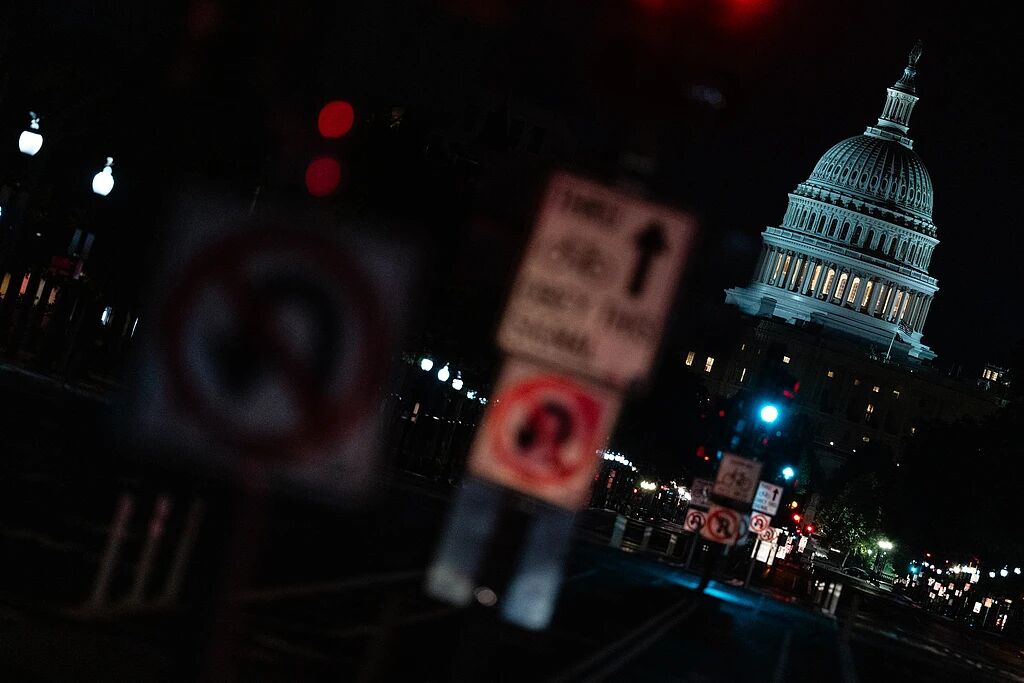
On October 1, the U.S. Capitol was in darkness
The direct cause of the shutdown is the infighting between the two parties. The budget proposed by the Republicans was blocked by the Democrats, leading to a stalemate and forcing the government to shut down.
According to convention, the new fiscal year for the U.S. federal government officially begins on October 1, and the government must submit 12 annual appropriations bills to Congress in advance to provide necessary operating funds.
If both chambers of Congress cannot approve these bills by midnight on September 30, government agencies will be forced to suspend non-essential operations due to a lack of funding.
Trump was no exception; he followed the procedure and submitted the new fiscal budget to Congress early for review. However, the process of passing this budget in Congress was fraught with challenges.
In the Republican-controlled House of Representatives, a "Continuing Resolution" aimed at avoiding an immediate shutdown passed on September 19 by a narrow margin of 217 votes to 212.
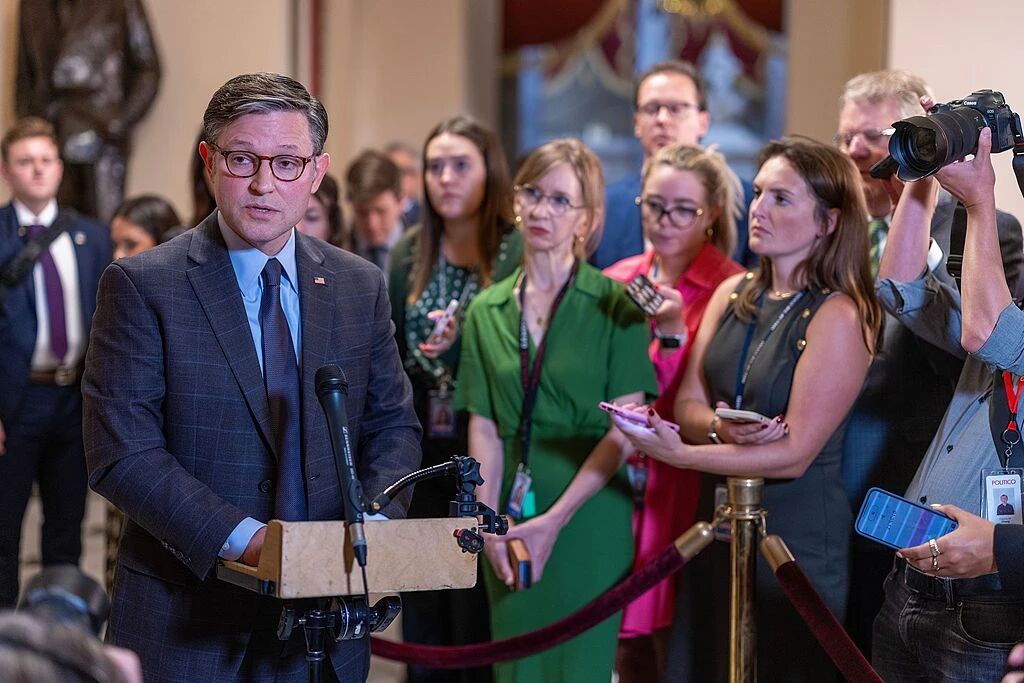
On September 19, the House of Representatives voted on the temporary funding bill
Compared to the formal annual budget, this temporary spending bill is merely a stopgap measure, but if it can also pass in the Senate, it would extend government funding until November 21, allowing more negotiation time for both parties.
However, in the Senate, Trump's luck did not hold.
The Senate requires any spending bill to pass with a "supermajority" of 60 votes. However, the Republican Party, to which Trump belongs, holds only 53 seats in the Senate, meaning that to pass the budget for the 2026 fiscal year, they must win over at least 7 Democratic senators.
The Democrats are particularly resistant to the Republican budget proposal due to clear "core differences" in fiscal policy.
Breaking it down, the Trump administration (Republicans) has two main demands.
▶▷ First, repeal the subsidies for the Affordable Care Act (ACA). The Trump administration believes that the tax subsidies in the ACA, a core political legacy of former President Obama, are "inefficient programs that need reform," and thus proposed to eliminate them entirely in the new fiscal budget.
▶▷ Second, strengthen border and immigration control. The budget proposal significantly increases funding for immigration and border enforcement, aiming to enhance border security while cutting funds related to asylum applications.
In response to the Republican budget proposal, the Democrats expressed strong opposition, with three main demands.
◎ First, invest $350 billion to retain and extend ACA subsidies. They firmly defend the Affordable Care Act and demand an extension of the soon-to-expire tax subsidies.
◎ Second, restore Medicaid and repeal the recent cuts to Medicaid in the Republican tax bill.
◎ Third, oppose the "extremization" of border policies. The Democrats believe that the Republican proposal to increase border security funding is too extreme and weaponizes and politicizes humanitarian issues.
House Minority Leader Hakeem Jeffries stated in an interview that the Democrats would not support a funding bill that "continues to harm the healthcare of ordinary Americans."
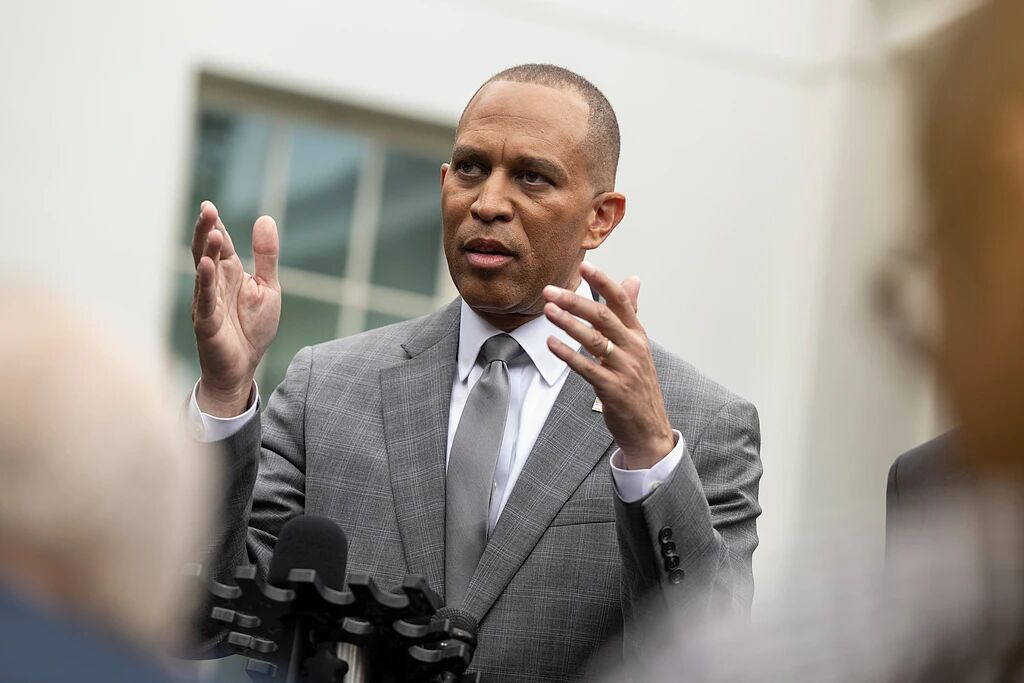
On September 29, Hakeem Jeffries spoke to the media
In summary, the direct cause of the U.S. government shutdown is the failure to pass the fiscal budget, the core reason for which lies in the partisan divisions between the Republicans and Democrats, and the fundamental cause of these divisions is the disagreement over healthcare budget, with the Democrats having the ability to block the budget's passage.
This is what led to the U.S. government taking a "National Day holiday" this year.
Trump "welcomes" it?
Although government shutdowns are not uncommon, this particular shutdown is "different" from previous ones. This is mainly reflected in President Trump's attitude and strategy.
First, Trump's attitude has shifted from "desperately avoiding" a shutdown to "welcoming" it.
The last government shutdown occurred in 2018 during Trump's first term. At that time, he not only tried to avoid a government shutdown but even canceled his New Year vacation plans to Mar-a-Lago after the shutdown began and convened Republican leaders on the first working day of the new year to discuss solutions.
This time, however, Trump seems to be allowing the government to shut down. The BBC commented: "The Trump administration seems very willing to keep a large part of the U.S. government closed for a long time."
In terms of actions, four days prior, Trump showed no interest in political affairs, taking Air Force One to watch a golf tournament and even canceled a meeting with Democratic representatives aimed at preventing the government shutdown. Even during the bipartisan talks on Monday, September 29, Trump insisted on his demands regarding the fiscal budget, showing no signs of compromise.
Trump blamed the Democrats for refusing to abandon their demands as the fundamental reason for the government shutdown, stating: "Nothing is inevitable; I think it was very likely (to avoid a shutdown). But I haven't seen them make any concessions."
After the bipartisan negotiations on Monday, U.S. Vice President Vance pessimistically stated: "I think we will face a government shutdown because the Democrats will not do the right thing."

Live broadcast of the Senate voting on the government funding bill
Some analysts believe that Trump's nonchalant attitude hides his "calculation": he is attempting to use the government shutdown as a tool to achieve his political goals.
William Resch, a professor at Georgia State University who specializes in government shutdowns, stated: "If past government shutdown crises were a high-stakes game of chicken, this shutdown is presenting a different form."
In the past, government shutdowns typically meant unpaid leave for non-essential employees, and once both parties reached a compromise, employees could return to work after funding was restored.
However, this year, Trump seems prepared to take advantage of the government shutdown to conduct a round of "mass layoffs."
On September 25, the Trump administration issued directives through the Office of Management and Budget (OMB), instructing agencies to prepare "employee reduction notices" with the aim of "eliminating departments that do not align with the president's priorities."
White House budget director Russell Vought also released a memo explaining how the Trump administration plans to use the government shutdown to achieve long-term cuts in federal spending and employment.
This indicates that Trump intends to turn this crisis into an opportunity to reshape the federal government: permanently closing or downsizing departments and projects that do not align with his political agenda.
This approach is indeed consistent with Trump's usual style. After all, when Trump first took office, he used Musk's help to eliminate several departments and significantly cut government spending.
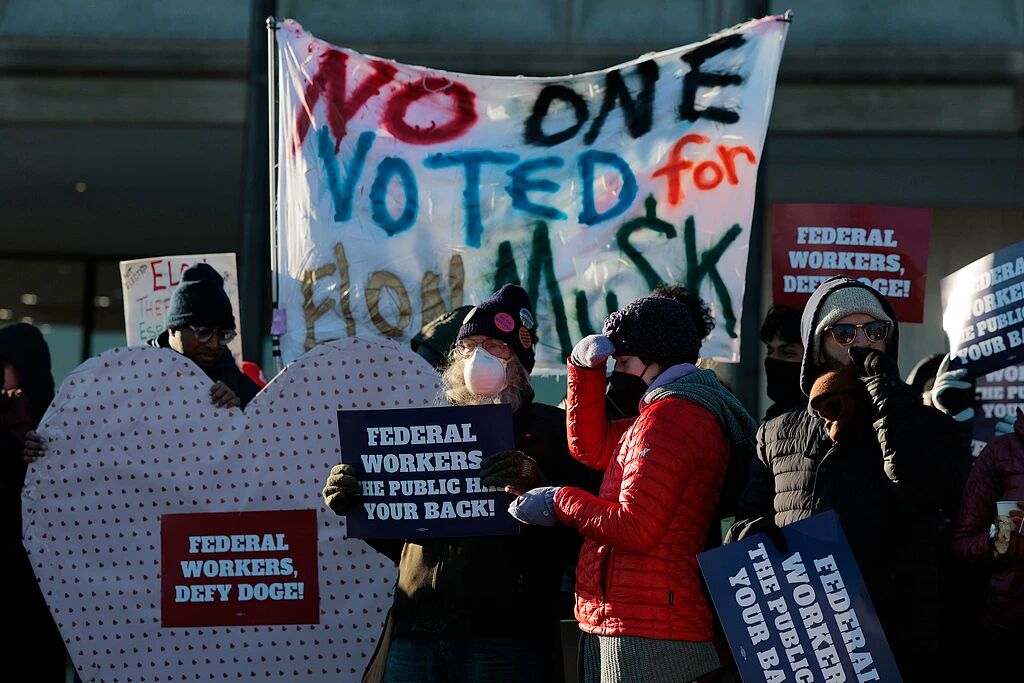
American citizens once protested against budget cuts to the U.S. Department of Efficiency
Peter Loge, director of the School of Media and Public Affairs at George Washington University, believes that unlike previous government shutdowns, Trump is behaving "much tougher" during his second term in the White House.
He believes that many senior Republicans and the president himself hope for a shutdown because "the power to determine which agencies and jobs can be eliminated is primarily held by the White House."
At the same time, they are confident and capable of successfully shifting the blame for the government shutdown onto the Democrats.
What are the costs of the U.S. government shutdown?
What are the consequences of a government shutdown in the U.S.? According to estimates from the Congressional Budget Office, the last 35-day shutdown caused direct economic losses of up to $11 billion to the U.S. economy. This current shutdown crisis is estimated to result in losses of about $400 million per day.
Taking the 2018 shutdown crisis as a reference, the specific impacts are as follows:
▶▷ First, federal employees face financial difficulties.
After the 2018 U.S. government shutdown, about 800,000 federal employees faced unpaid work or forced leave, directly affecting their families' livelihoods. The absence of key positions would lead to partial paralysis of government functions.
▶▷ Second, risks to national and public safety.
In the field of aviation security, the Transportation Security Administration (TSA) and air traffic controllers faced staff shortages, leading to significantly longer security check times and exposing the U.S. aviation system to "unprecedented risks." The FBI's investigative resources would be stretched to the limit, affecting counter-terrorism, criminal investigations, and intelligence work.
▶▷ Third, a public health and welfare crisis.
Due to the Food and Drug Administration (FDA) suspending most routine inspections, there would be a regulatory vacuum for food and drug safety nationwide, making it highly likely for food and drug safety issues to arise across the country.
With the government shutdown, social welfare programs would be interrupted, affecting food voucher programs (WIC) for millions of pregnant women and children, halting agricultural loans, and harming farmers' interests.
▶▷ Fourth, disruptions in the judicial and military systems.
The 2018 shutdown crisis led to delays in over 42,000 immigration cases in the U.S.; the federal court system quickly ran out of funds, making it difficult to maintain normal operations. This time, the situation will be even more severe. Department of Homeland Security (DHS) Secretary Kristjen Nielsen stated: "This will force over 150,000 officers and nearly 50,000 military personnel to continue defending our nation without pay."
▶▷ Fifth, delays in the release of economic data.
On September 27, the U.S. Department of Labor released an emergency plan, clearly stating that its subsidiary, the Bureau of Labor Statistics (BLS), would fully suspend operations, which means that the non-farm payroll data for September, originally scheduled for release on October 3, will be delayed.
If the government shutdown cannot be resolved in the short term, subsequent reports such as the Consumer Price Index (CPI) and initial jobless claims will also be postponed. This will impact financial markets in the U.S. and globally.
However, a "shutdown" does not mean a complete "shutdown" of government functions.
According to the Anti-Deficiency Act, essential functions that ensure the safety of life and property (such as the President, Congress, active military personnel, and certain law enforcement officers) will continue to operate. For example, 258,000 employees of the Department of Homeland Security will not be furloughed.
Additionally, ongoing expenditures that do not require regular appropriations from Congress will continue to operate normally, meaning that Americans can still receive Social Security benefits and access federal Medicare and Medicaid.
Furthermore, border protection, hospital care, air traffic control, law enforcement, and power grid maintenance are considered essential services and will remain operational during the government shutdown.
Of course, this exists only in theory. During the last government shutdown, some departments were affected in their functions due to a lack of employees.
These are just some of the consequences of the U.S. government shutdown. A more serious consequence is the increased distrust of the American government among the American people, which also has a significant negative impact on the international image of the U.S.
CNN once commented on the U.S. government shutdown: "The government shutdown is weakening America, leaving both its allies and adversaries confused. It is damaging America's status and reputation while undermining its power and influence. The democratic system that once inspired the world now leaves observers perplexed."
Thus, CNN believes that when the U.S. government shuts down, "America's enemies must be laughing."
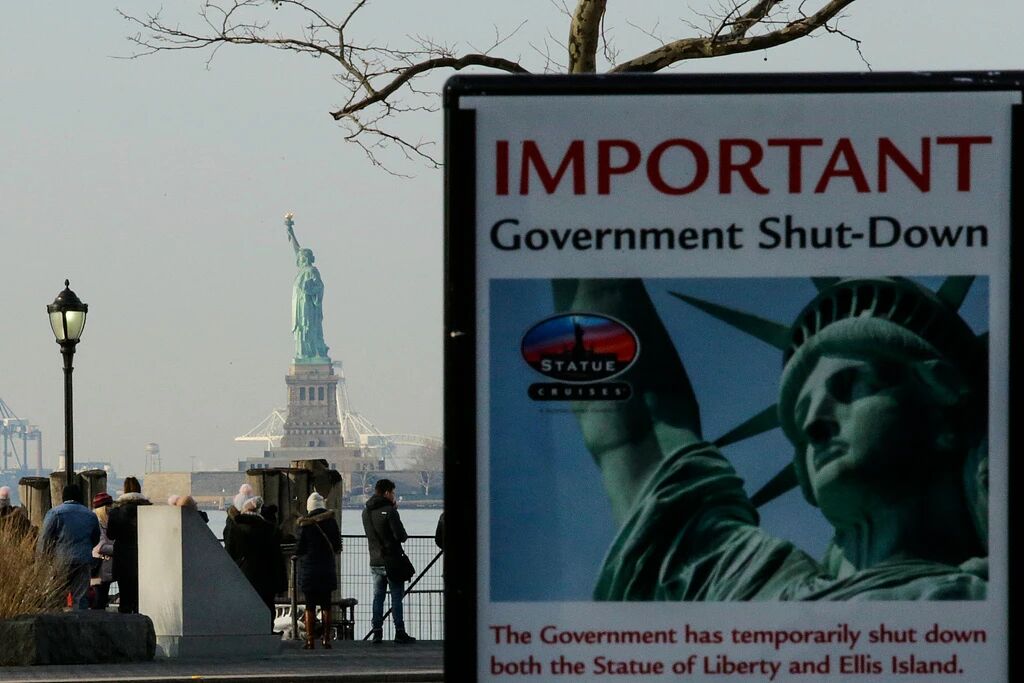
In 2018, during the U.S. government shutdown, the Statue of Liberty attraction was forced to close.
What about the future after the U.S. government shutdown?
Although the U.S. government shutdown is significant, the financial markets seem to have "digested" its negative impacts.
On the eve of the government shutdown, the three major U.S. stock indices opened lower but rose throughout the day. The Dow Jones Industrial Average increased by 0.18%, the Nasdaq by 0.3%, and the S&P 500 by 0.41%, with all three indices showing resilience and not being affected by the government shutdown.
Overseas analysts believe that, from Washington's perspective, the market generally expected the government to shut down, so investors remained inactive. However, if the shutdown lasts more than two weeks, concerns will begin to arise.
As a result, we see spot gold surging by 0.65%, priced at $3,857.83 per ounce, reaching a new high. Clearly, the risk-averse sentiment in global financial markets remains strong.
The last government shutdown during Trump's administration lasted for 35 days; how long will this one last?
In a memo, Office of Management and Budget Director Vought wrote: "It is currently unclear how long the Democrats' position will hold, so the duration of this government shutdown is difficult to predict."
For Trump and Democratic leaders, the shutdown starting on Wednesday appears to be a domestic political contest, but for people in other parts of the world, the closure of U.S. government agencies signifies that America is becoming smaller, shortsighted, and unreliable.
As CNN commented: "The glory of the superpower ends here, as it shuts down."
免责声明:本文章仅代表作者个人观点,不代表本平台的立场和观点。本文章仅供信息分享,不构成对任何人的任何投资建议。用户与作者之间的任何争议,与本平台无关。如网页中刊载的文章或图片涉及侵权,请提供相关的权利证明和身份证明发送邮件到support@aicoin.com,本平台相关工作人员将会进行核查。




